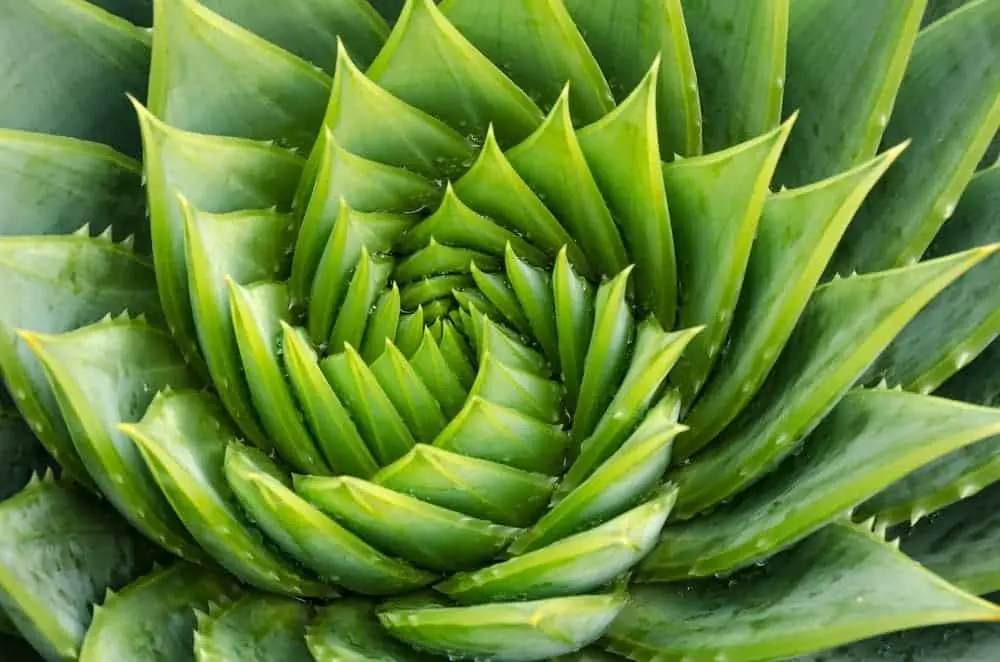For a long time, the Aloe Vera plant has been used for a variety of health issues, including healing burns, improving digestive health, clearing acne, and so much more.
It has been used for its gel and juice. Many have an Aloe Vera plant in their home. It is a succulent and an easy plant to care for and grow. The plant originated in the tropical climates of Africa.
Aloe Vera Plant Care and Growing Guide
1. About Aloe Vera Plant
The Aloe Vera Plant is a species of the genus Aloe and is very short-stemmed or stemless. It has thick, fleshy, greenish leaves that fan out from the central stem of the plant. On the margin of the leaf, you can see that it is serrated with small teeth.
They make great indoor plants as well as great outdoor plants in flowerbeds and rockeries. Due to its potent anti-inflammatory properties, this is why it has a long history of being used in folk medicine. Its nickname is the Medicine Plant and is considered a drought-resistant succulent.
2. Light Requirement
They require very bright, indirect sunlight. In the winter the Aloe Vera plant should be housed in a bright location with some direct sun. This plant can also sunburn as you can. On average, they need about six hours of direct sunlight. Be careful moving the plant from a shady area into direct sunlight as you can burn the leaves.
3. Water
Being a drought, resistant succulent, when you water it, do it thoroughly and then allow the soil to completely dry out before you water it again. Sometimes it can be two-three weeks before you need to water. It all depends on where the plant is located, the type of potting soil used, and the weather.
In the wintertime, it needs even less moisture. Although an Aloe Vera plant can be saved from severe under-watering it can rarely be saved if you over-water it. Make sure that you feel the plant to make sure that it needs water before doing it. If it does not get the water it needs, it will shorten the lifespan of the plant.
4. Climate
Zones 10-11
5. Soil
The Aloe Vera plant can grow in almost any soil but it prefers a soil that is well-aerated, quick-draining with some sand in it. You can also use a cactus potting soil. You need soil that is pH neutral

6. Fertilizer
The Aloe Vera plant prefers a type of fertilizer that is different from most other houseplants. You should feed it monthly with 10-40-10 plant food. Make sure that it has been diluted to one-half of the strength that is recommended.
7. Temperature
The plant likes to have dry, warm temperatures between 65-85 degrees Fahrenheit. If the temperature is below 40 degrees Fahrenheit, it will not do well. They require little humidity as they are native to the deserts. Make sure that you keep them away from cold drafts and air conditioning.
8. Speed of Growth
Grown indoors, the Aloe Vera plan can take three to four years to become a mature plant. If you want it to grow faster boost the growth rate with fertilizer and provide your plant with optimal care. An increase in the size of your plan should happen in a period of four months. An indoor plant grows slower than if it was grown outside.
learn more: Gooseneck Loosestrife
9. Height and Spread
The Aloe Vera plant can grow up to three feet but on average, the ones that people keep indoor range from one to two feet tall. Their leaves can grow to eight to ten inches.
10. Flowers
The flowers bloom in the summer and can be pink, white, orange, or red.
11. Trimming
They are a plant that rarely needs to be trimmed
12. Repotting
This is important for the young plants as they outgrow the pots they were in. It is simple to repot this plant. The first thing that you need to do is see if there are any offsets and if so, you need to save them for propagation. Repot it in a pot one or two size bigger.
13. Propagation
You can propagate Aloe Vera by using the small plants that grow around the base of the main plant. These are called suckers or offsets. When removing these offsets you need to do it gently and let them dry for one to two days. By doing this, you are helping to prevent the sap from running out.
Plant them in a small pot with a sandy potting mix, which is required when trying to grow new plants. You can make your own by mixing equal parts of sand and regular potting mix. Once this is done, then you water them well and put it in a dry, warm, sunny location. This plant roots easily. It is best if this is done during the summer and spring.
Keep reading: Eugenia Topiary: Plant Care & Growing Guide
Is the Aloe Vera Plant Poisonous?
Yes, the Aloe Vera plant is poisonous to children and pets if it is ingested but the sap, of course, is not.
More like this: Flowering Kalanchoe: Plant Care and Growing Guide
Common Aloe Vera Plant Problems
- Soft mushy leaves and root rot: This is from over-watering your plant.
- Leaves becoming almost transparent on one side: The air around the Aloe Vera plant is too cold.
- Warty growth on stems and leaves: This can be caused by Aloe Mites, which is the one pest that infects Aloe Vera plants. Once you see these lumps, it almost impossible to reverse. These mites travel in the wind so you should throw the plant away to avoid infesting other plants.
- Tips of leaves turning yellow: This can be due to too much direct light or not watering correctly.
There are very few other plant pests that bother this plant.
Conclusion
When you have an Aloe Vera plant, you just need to have a small pot but should have drip or drain holes in the bottom so that the soil will quickly dry out to help prevent root rot. The Aloe Vera plant is considered a clean air plant.
It will help to remove benzene from the air. This is released from chemical cleaning products. It also has various classifications such as xerophytic, perennial, and succulent.
Also keep:
- Clematis Care & Growing Guide
- Pothos vs Philodendron – How to tell the difference
- Lucky Bamboo: Plant Care
Victoria is the owner and main author of hobby plants. She loves spending her free time in her garden planting and taking care of her plants. Victoria hopes you enjoy the content here!
![Why Is My Aloe Plant Turning Brown? [FIND OUT HERE] Why Is My Aloe Plant Turning Brown? [FIND OUT HERE]](https://www.hobbyplants.com/wp-content/uploads/2022/07/why-is-my-aloe-plant-turning-brown-300x158.jpg)


![Mother Of Thousands Plant [Complete Plant Care Guide] Mother Of Thousands Plant [Complete Plant Care Guide]](https://www.hobbyplants.com/wp-content/uploads/2022/07/mother-of-thousands-plant-300x158.jpg)
![Majesty Palm Plant Care: [Complete Beginner's Guide] Majesty Palm Plant Care: [Complete Beginner's Guide]](https://www.hobbyplants.com/wp-content/uploads/2022/08/majesty-palm-care-300x158.jpg)
![Exotic Angel Plant Care: [Complete Beginner's Guide] Exotic Angel Plant Care: [Complete Beginner's Guide]](https://www.hobbyplants.com/wp-content/uploads/2022/08/exotic-angel-plant-care-300x158.jpg)
![Snow White Waffle Plant: [Complete Care Guide] Snow White Waffle Plant: [Complete Care Guide]](https://www.hobbyplants.com/wp-content/uploads/2022/08/snow-white-waffle-plant-300x158.jpg)
![Waffle Plant Care: [Complete Beginner's Guide] Waffle Plant Care: [Complete Beginner's Guide]](https://www.hobbyplants.com/wp-content/uploads/2022/08/waffle-plant-300x158.jpg)
![Bird Of Paradise Plant Care: [Complete Beginner's Guide] Bird Of Paradise Plant Care: [Complete Beginner's Guide]](https://www.hobbyplants.com/wp-content/uploads/2022/08/bird-of-paradise-plant-300x158.jpg)
![Purple Passion Plant Care: [Complete Beginner's Guide] Purple Passion Plant Care: [Complete Beginner's Guide]](https://www.hobbyplants.com/wp-content/uploads/2022/08/purple-passion-plant-care-300x158.jpg)
![China Doll Plant Care: [Complete Beginner's Guide] China Doll Plant Care: [Complete Beginner's Guide]](https://www.hobbyplants.com/wp-content/uploads/2022/09/china-doll-plant-care-300x158.jpg)
![Polka Dot Plant Care: [Complete Beginner's Guide] Polka Dot Plant Care: [Complete Beginner's Guide]](https://www.hobbyplants.com/wp-content/uploads/2022/09/polka-dot-plant-300x158.jpg)